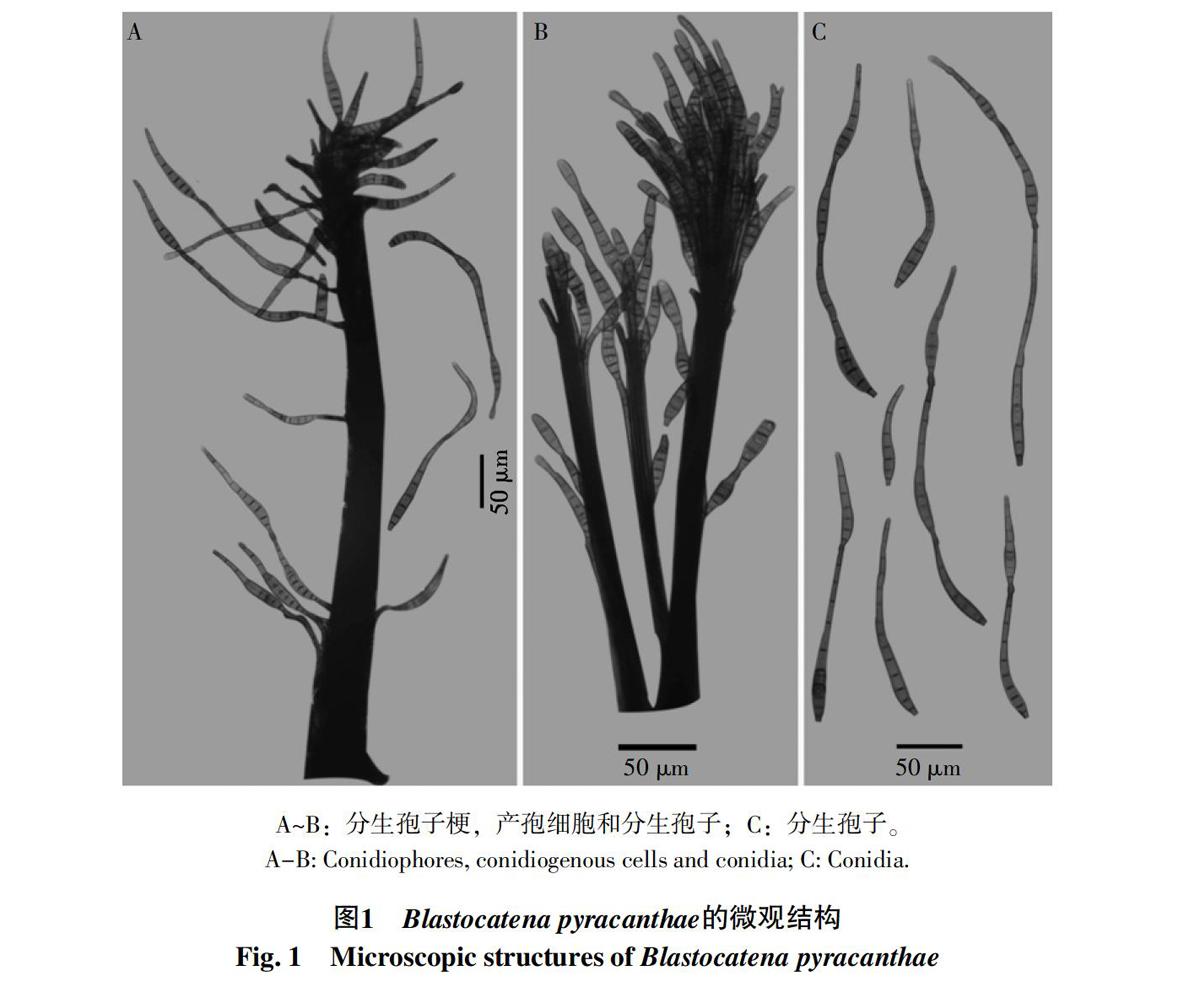中国贵州芽串孢属一新种
2015-10-21李小霞肖仲久
李小霞 肖仲久

摘 要 通過对采自贵州省习水自然保护区暗色丝孢真菌的处理,发现了一个芽串孢属新种——火棘芽串孢Blastocatena pyracanthae,并对其进行了形态学特征描述和图解。研究标本保存在遵义师范学院真菌标本室(HMZNC)。
关键词 分类;火棘芽串孢
中图分类号 Q939 文献标识码 A
1 Introduction
During a continuing exploration for saprobic microfungi in Xishui National Nature Reserve of Guizhou, China, Blastocatena pyracanthae as one new species was collected and identified. The genus Blastocatena was erected by Subramanian, et al[1] with B. pulneyensis Subram. & Bhat as the type species. It was mainly characterized by macronematous, unbranched conidiophores aggregating into erect, cylindrical, dark brown synnemata, and integrated, terminal, monoblastic, determinate conidiogenous cells that produce holoblastic, distoseptate conidia in acropetal, unbranched chains. The characters separate Blastocatena from its similar genera Parablastocatena Y.D. Zhang & X.G. Zhang[2] and Lylea Morgan-Jones[3]. The conidia of Parablastocatena are euseptate, and the condiophores of Lylea are micronematous and mononematous and the conidial chains are branched. Until now, only one species has been reported in Blastocatena.
2 Materials and methods
Specimens of decomposed branch collected in Xishui National Nature Reserve, Guizhou Province, were incubated in Petri dishes(d=9 cm)with mositened filter paper at 27 ℃ in a SPX-250B-Z Biochemical Incubator for 2-3 weeks. Then samples were examined at regular intervals under an Olympus SZ61 stereo microscope. Conidiophores and conidia were removed from the surfaces of the decomposed branches with a needle, and transferred to a drop of lactophenol on a slide, and then the cover slips were sealed with netral balsam. Finally, the slides were evaporated in a drying oven(55 ℃). Micrographs were taken with an Olympus BX51 microscope.
3 Descriptions
Blastocatena pyracanthae Z.J. Xiao & X.X. Li, sp. nov.
Fungal Name FN570083
Colonies effuse on decomposed branch dark brown, hairy. Mycelium partly superficial, partly immersed in the substratum. Conidiomata synnematous, solitary, erect, dark brown, cylindrical, fertile in the upper part, becoming scatter toward the apex, up to 1 300 μm high, up to 110 μm wide at the swollen base, 31-68 μm wide in the middle. Conidiophores macronematous, synnematous, unbranched, septate, smooth, brown to dark brown, up to 1 300 μm long, 3.5-6.0 μm wide, diverging laterally and terminally. Conidiogenous cells monoblastic, intergrated, terminal, smooth, cuniform to lageniform, 4.5-6.0 μm wide in the middle, 3.0-4.0 μm wide at the truncate apex. Conidia holoblastic, obclavate, developing in acropetal chains or sometimes solitary, 5-14-distoseptate, smooth walled, brown, 59-184 μm long, 8.0-13.5 μm wide in the widest part, 2.5-4.0 μm wide at the truncate base, with apex extended into a hyaline to subhyaline beak 2-3 μm wide.
Specimen examined: on decomposed branches of Pyracantha fortuneana(Maxim.)Li, Guizhou Province, China, 18 Jun. 2013, HMZNC 0008.
Blastocatena pyracanthae is morphologically similar to B. pulneyensis in synnematous conidiophores, and distoseptate conidia developing in acropetal chains(Fig. 1). However, the conidia of B. pyracanthae are obclavate while those of B. pulneyensis are obovoid to cylindrical. In addition, the conidia of B. pyracanthae are longer than those of B. pulneyensis(59-184, 5-14 μm vs. 21-44, 3-5 μm),and there are more distoseptate(5-14 vs. 3-5),which are obviously different from the B. pyracanthae.
References
[1] Subramanian C V, Bhat D J. Hyphomycetes from South India I. Some new taxa[J]. Kavaka, 1987, 15(1-2): 41-74.
[2] Zhang Y D, Ma J, Ma L G, et al. Parablastocatena tetracerae gen. et sp. nov. and Corynesporella licualae sp. nov. from Hainan, China[J]. Mycoscience, 2012, 53(5): 381-385..
[3] Morgan-Jones G. Notes on Hyphomycetes. VIII. Lylea, a new genus[J]. Mycotaxon, 1975, 3(1): 129-132.
